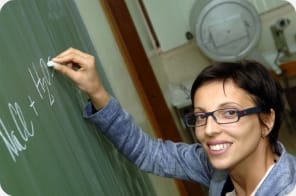Science Teaching Certification

Look around you and notice the objects, people, plants, and animals that make up your surroundings. In reality, these things are really just a collection of billions of molecules and atoms that are the building blocks of life.
To most students (and adults!) this is a confusing fact to imagine – that we’re made up of cells and structures working in unison that allow us to effectively function in everyday life. But it’s a fact made easier to understand thanks to the work of certified science teachers.
On This Page…
| What is Certification? |
| Unifying concepts of science |
| Life Sciences |
| Earth and Space Sciences |
| Physics and Chemistry |
| Goals of laboratory experiences |
| Find Schools offering teaching certification programs |
During high school, students expand the basic concepts they’ve learned about earth, biology, space, life science, and physics. Students need certified and effective teachers to explain these complex topics – teachers who know both the subject matter, as well as knowledge of the most effective ways to teach.
Science teachers design lab experiments, understand the fundamental concepts and laws behind scientific knowledge, and hold the ability to accurately and effectively explain these concepts to their students.
In order to ensure these teachers have the tools necessary to teach their students, they must complete the certification process, which proves that these teachers are effective educators.
What is certification?
Science teacher certification shows that teachers understand the concepts behind high school science pedagogy, and have the ability to break down complex theories and laws into manageable facts.
The certification process tests teachers on their content knowledge and their knowledge of effective teaching methods. Before becoming certified, teachers must prove they know how to organize curricula, work with students through difficult and confusing concepts, and design and implement a wide variety of science activities.
In order to pass science certification, what subject and concepts do teachers need to understand (explore your states requirements for certification here)?
- Nature of scientific evidence and use of models for explanation
<
- Measurement as a way of knowing and organizing observations of consistency and change
- Ways of organizing perceptions of the world such as systems and classification
- Evolution of natural systems and factors that result in evolution or equilibrium
- Interrelationships of form, function, and behaviors in living and nonliving systems
Source: Standards for Science Teacher Preparation
Life sciences
During high school, students learn additional details about what makes up the world around them. In order to effectively explain to students the biology of life, teachers must show an understanding of cells, genetics, evolution, and the classification of plants and animals.
Science teachers understand the composition of cells, including structure and function. To become certified, they must also show how these cell structures contribute to the cycle of life, and what happens if these cell structures cease to function.
- Ask a question
- Observe facts
- Develop a hypothesis
- Test the hypothesis in experimentation
- Analyze Data
- Draw conclusions
High school science classes explore the behavior of organisms – from the smallest bacteria to the largest mammal. Certified science teachers know how evolution contributes to the development and behaviors of these organisms, and how organisms interact and sustain each other.
For example, a science teacher should understand how introducing a foreign organism to an ecosystem could affect that ecosystem – either negatively or positively.
The certification process also tests teachers on their understanding of plants, including the structure and function of roots, stems, and leaves. Teachers should show how plants take in sunlight, transfer it into energy, and how this energy transfers to other organisms who consume the plants.
Using their knowledge of biology and life sciences, teachers are equipped to design interesting and engaging laboratory experiments that show students how the knowledge they learn is put to use in a real-life setting.
During the certification process, teachers are asked how they would present certain topics, so a science teacher with an understanding of animal anatomy might discuss conducting a dissection lab with his or her students.
In addition to life sciences, teachers should understand the concepts and principles involved in earth and space sciences.
Earth and space sciences
Looking at the stars, it’s hard to imagine how close or faraway they are from earth. In fact, sometimes understanding concepts of space and the atmosphere seems entirely out of reach.
While students spend much of their high school science classes memorizing facts and figures, they also have the chance to apply this knowledge in the laboratory.
Click here to read more about the goals of laboratory experience…
But science teachers undergoing the certification process must demonstrate an understanding of these space and earth sciences, and how earth fits into the universe. Earth science teachers have a thorough understanding of the physical geology of earth, including its minerals, rocks, and fault lines.
They also understand how these minerals and fault lines contributed to the creation of earth, and the formation of geologic features like mountains, oceans, canyons, and volcanoes.
Certified science teachers must also understand theories of the origin of the universe, and how stars, planets, and other major features comprise the universe. With an understanding of these topics, potential science teachers are well prepared for the certification process.
Science teachers should also demonstrate how the waves, tides, and currents affect meteorology concepts, like properties of the atmosphere, clouds, precipitation, and the climate. They are able to effectively explain to their students how weather patterns develop, and understand the basics of weather prediction.
During high school, students also begin to learn about complex topics such as physics and chemistry, topics that rely on mathematical concepts, and are more demanding than the middle-school sciences introduced to students in the past.
Physics and chemistry
Certification also tests potential teachers on their knowledge of the physical sciences, including physics and chemistry.
Potential teachers must show an understanding of the basic properties of matter, and the principles behind matter interactions. This includes how forces like gravity exert themselves on matter, and how energy transfers from one object to another.
Before receiving certification, teachers need to understand the laws of motion, with regards to speed, displacement, and inertia, and how mass and weight affect these factors. Using physics, teachers show their students how moving objects increase or decrease in speed, and how this affects the force of these objects.
Physics teachers also understand how mechanical devices such as screws, levers, and pulleys work. Through laboratory experiments testing these devices, teachers show how they are combined into complex machines their students might use in everyday life, such as cars.
In addition to physics, potential science teachers must also display an understanding of another math-heavy science topic – chemistry.
Those undergoing the certification process must show an understanding of chemistry concepts like the periodic table, and how elements make up the world. Certification tests teachers on their knowledge of the elements in the periodic table, such as an element’s atomic number, chemical reactivity, and physical properties.
Teachers must also demonstrate how chemicals bond to each other, and factors that affect bonding, such as temperature, concentration, and catalysts. Certification exams test potential teachers on this knowledge, necessitating a fundamental understanding of chemistry topics.
Because much of the time chemistry teachers spend educating their students occurs in a laboratory setting, teachers must also prove they know the safety regulations of handling chemicals, as well as an understanding of the lab equipment used. Teachers should know the proper safety protocols if a chemical is spilled or a student comes in contact with a potentially harmful chemical.
Gaining certification
If you’re interested in learning more about the certification process, request more information from your state’s certification page.
Goals of laboratory experiences
While students spend much of their high school science classes memorizing facts and figures, they also have the chance to apply this knowledge in the laboratory.
Giving students lab experience is a large part of teaching high school science, and is one of the best ways of showing students how scientific knowledge is reflected in the real world. Real-life scientists spend much of their working days in the lab, testing hypotheses, checking facts, and reaching conclusions.
According to “America’s Lab Report: Investigations in High School Science,” by Susan R. Singer and others, science “is a human endeavor that seeks to understand the material world and that scientific theories, models, and explanations change over time on the basis of new evidence.”
To reach this new evidence, students must understand the goals of experimentation, and how these goals promote the discovery of new evidence.
The first goal of lab work is to enhance students’ mastery of science subject matter. Singer and others note that lab experiences give students a more intimate look at the subjects they learn, allowing them to expand their knowledge.
Lab work also allows students to develop scientific reasoning skills that promote their abilities to develop questions and concepts that drive future lab work. Arguing a case becomes a major part of scientific work, so students must develop skills for constructing reasoned arguments, skills to respond to critical comments, and writing skills using scientific language.
During lab experiments, students also learn to use the tools and conventions of science. This includes making observations, taking measurements, and carrying out the scientific method. These practical skills follow them throughout their scientific lives, helping them understand the value of memorizing such facts in the classroom.
Lab time gives teachers a chance to make what could seem like an endless series of learned facts into something tangible and applicable for their students.







